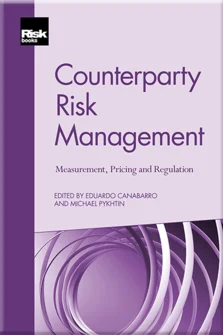CVA Risk Management Post-Crisis
David Goulding
CVA Risk Management Post-Crisis
The Basel III Enhancements to Counterparty Risk Capital Charges
The Regulation of Counterparty Risk in Over-the-Counter Derivatives Markets
The Non-Internal Model Method for Counterparty Credit Risk
On Credit Valuation Adjustments and Regulatory Capital
American Monte Carlo: A Practitioner Approach
Best Market Practice for Calculation and Reporting of Wrong-Way Risk
Central Counterparty Risk
CVA Risk Management Post-Crisis
Re-Thinking CVA: Valuations, Counterparty Credit Risk and Model Risk
Should Derivatives Dealers Make A Funding Value Adjustment?
Adjoint Algorithmic Differentiation: Real-Time Counterparty Credit Risk Management in Monte Carlo Simulations
Stress Test of Counterparty Risks and Dynamic Hedging of the CVA
Dynamic Stress Testing of Counterparty Default Risk
Collateral: Modelling, Pricing and Optimisation

Since 2008 the importance of credit value adjustment (CVA) and the desks hedging it have grown within banks, and in this chapter we discuss the issues around pricing, hedging and managing CVA risk. At a high level the reason for the growth was twofold: first, the realisation during 2007–8 that relatively small CVA balances can explode on in essence the same positions; second, the new regulatory capital requirements around CVA.
The growth in CVA balances was caused by the unique feature of CVA in that it grows as credit spreads increase and as the underlying counterparty exposures increase. During the global financial crisis (ie, 2007–9) both spreads and exposures increased by multiples which overall led to an order of magnitude increase in CVA.
The new regulatory capital requirements arose from the realisation that some banks were incurring large losses due to poorly hedged CVA balances. This led to CVA and its associated hedges entering into the bank’s capital framework via the Basel III CVA value-at-risk (VaR) and regulatory stress-testing regimes. With these changes, CVA is often the largest single capital constraint on trading activity.
In this chapter we discuss the
Copyright Infopro Digital Limited. All rights reserved.
As outlined in our terms and conditions, https://www.infopro-digital.com/terms-and-conditions/subscriptions/ (point 2.4), printing is limited to a single copy.
If you would like to purchase additional rights please email info@risk.net
Copyright Infopro Digital Limited. All rights reserved.
You may share this content using our article tools. As outlined in our terms and conditions, https://www.infopro-digital.com/terms-and-conditions/subscriptions/ (clause 2.4), an Authorised User may only make one copy of the materials for their own personal use. You must also comply with the restrictions in clause 2.5.
If you would like to purchase additional rights please email info@risk.net






